#trade edition
Photo


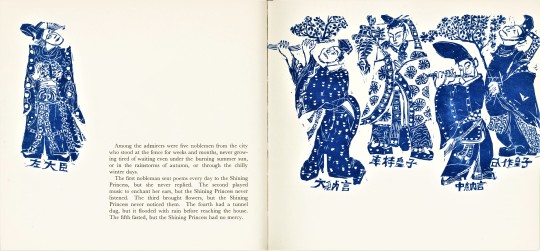

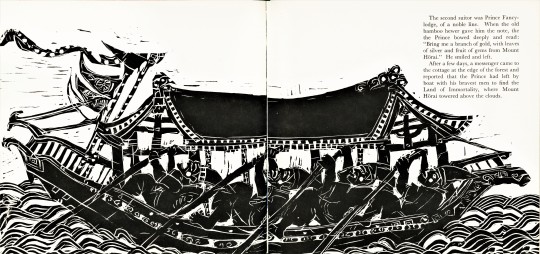

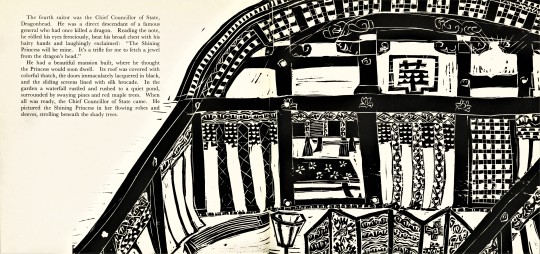

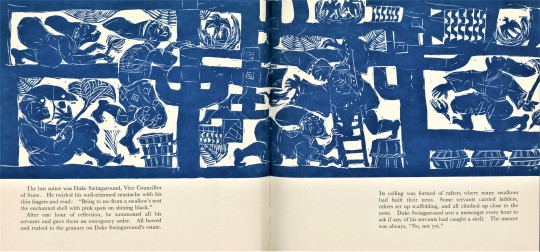
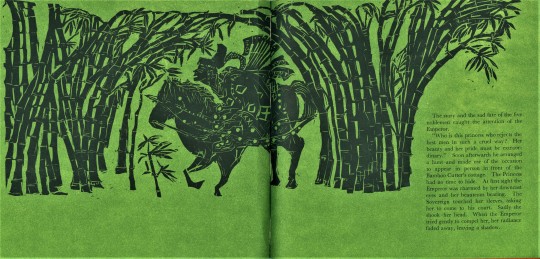
Staff Pick of the Week
My staff pick this week is the trade edition of The Tale of the Shining Princess by Japanese-born writer Hisako Matsubara (b.1935) and Japanese-Canadian artist-printmaker Naoko Matsubara (b.1937), published by Kodansha International LTD. Tokyo, Japan in 1966.
As a artist-printmaker and bookmaker who makes woodcuts, I am greatly inspired by Naoko’s prints. Naoko Matsubara’s work carries on traditions of Japanese printmaking while having its own contemporary flavor. Her woodcuts are ecstatic, they are vibrating with movement. Her use of bold shapes and the white line of the the carving tool makes the most of what woodcut has to offer. In the book form, the active images carry the reader’s eyes through the book space. Her use of negative space activates the page. Additionally, her woodcuts have translated beautifully to commercial printing.
The Matsubara sisters are daughters of a senior Shinto priest, and were raised in Kyoto. Both studied, lived, and worked in the United States. Hisako received her Master of Arts degree from Pennsylvania State College, moving to Germany where she continued her studies and became a prominent writer, publishing her work in Japanese, English, and German. In the 1980s she moved back to the United States, this time to California where she worked at Stanford University.
Naoko received her Master of Fine Arts from Carnegie Institute of Technology in Pittsburgh, now Carnegie Mellon University. After her studies she traveled across Europe and Asia. She returned to the United States and became the personal assistant to the artist and wood engraver Fritz Eichenberg, an artist who has been featured many times on our blog. Naoko taught at Pratt University in New York and at the University of Rohde Island. She also lived in Cambridge, Massachusetts for a time. Naoko is currently living and working in Canada in Oakville, Ontario, where she continues to work and exhibit nationally.
The work of both Hisako and Naoko have had great influence inside the United States and around the world. So lets celebrate their accomplishments!
This book has end sheets of mulberry paper with inclusions of Bamboo leaves, the cover is a red textured paper with a gold stamped design by Naoko.
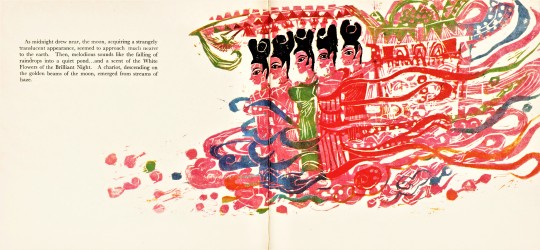


View some of our other AAPI selections for this month.
View our other Staff Picks.
- Teddy, Special Collections Graduate Intern
#staff pick of the week#The Tale of The Shining Princess#hisako matsubara#naoko matsubara#Japanese artists#Japanese writers#Japan#AAPI Hertitage Month#Asian American and Pacific Islander Heritage Month#AAPI#canadian artists#trade edition#Matsubara#woodcuts#printmaking#color printmaking#fiction#stories#teddy
413 notes
·
View notes
Text
Cold Iron in folklore, fiction, and RPGs
'Gold is for the mistress—silver for the maid!
Copper for the craftsman cunning at his trade.'
'Good!' said the Baron, sitting in his hall,
'But Iron—Cold Iron—is master of them all!'
— Rudyard Kipling, “Cold Iron”
Folklore

Drudenmesser, or "witch-knife", an apotropaic folding knife from Germany
The notion that iron (or steel) can ward against evil spirits, witches, fairies, etc is very widespread in folklore. You hang a horseshoe over your threshold to deny entry to evil spirits, you carry an iron tool with you to make sure devils won't assault you, you place a small knife under the baby's crib to ward it from witches, and so on. Iron is apotropaic in many many cultures.
In English, we often come across passages that refer to apotropaic cold iron (or cold steel). "All uncouth, unknown Wights are terrifyed by nothing earthly so much as by cold Iron", says Robert Kirk in 1691, which I believe is the earliest example. "Evil spirits cannot bear the touch of cold steel. Iron, or preferably steel, in any form is a protection", says John Gregorson Campbell in 1901.
Words
So what is cold iron? In this context, it’s just iron. The “cold” part is poetic, especially – but not only – if we’re talking about either blades (or swords, weapons, the force of arms) or manacles and the like. It just sounds more ominous. There are “cold yron chaines” in The Fairie Queene (1596), and a 1638 book of travels tells us that a Georgian general (in the Caucasus) vowed “to make the Turk to eat cold iron”.
Green’s Dictionary of Slang defines “cold iron” as a sword, and dates the term to 1698. From 1725 it appears in Cant dictionaries (could this sense be thieves’ cant, originally? why not, plenty of words and expressions started as underworld slang and then entered the mainstream), and from ~1750 its use becomes much more common.

NGram Viewer diagram for 1600-2019.
In other contexts, cold iron is (surprise!) iron that’s not hot. So let’s talk a bit about metallurgy.
Metals

In nature, we can find only one kind of iron that’s pure enough to work with: meteoritic iron. It has to literally fall from the sky. Barring that very rare occurrence, people have to mine the earth for iron ore, which is not workable as is. To separate the iron from the ore we have to smelt it, and for that we need heat, in the form of hot charcoals. Throwing the ore on the coals won’t do much of anything, it’s not hot enough. But if we enclose the coals in a little tower built of clay, leaving holes for air flow, the temperature rises enough to smelt the ore. That’s called a bloomery.

clay bloomery / medieval bloomery / beating the bloom to get rid of the slag
What comes out of the bloomery is a bloom: a porous, malleable mass of iron (that we need) and slag (byproducts that we don’t need). But now we can get rid of the slag and turn the porous mass to something solid, by hammering the hot bloom over and over. And once the slag is off, by the same process we can give it a desired shape in the forge, reheating it as needed. This is called “working” the iron, hence “wrought iron” objects, i.e. forged.

a blacksmith in his forge, with bellows, fire, and anvil (English woodcut, 1603)
This is the lowest-tech version, possibly going back to ~2000 BCE in Nigeria. If we add bellows, the improved air flow will raise the temperature. So smelting happens faster and more efficiently in the bloomery, and so does heating the iron in the forge, making it easier to work with. And that’s the standard process from the Iron Age all through the middle ages and beyond (although in China they may have skipped this stage and gone straight to the next one).
If we make the bloomery bigger and bigger, with stronger and stronger bellows, we end up with a blast furnace, a construction so efficient that the temperature outright melts the iron, and it’s liquified enough to be poured into a mould and acquire the desired shape when it cools off. This is “cast iron”.
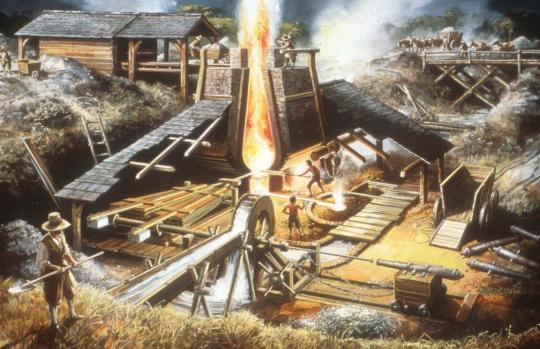
a blast furnace
So in all of this, what’s cold iron? Well, it’s iron that went though the heat and cooled off. (No heat = no iron, all you got is ore.) If it came out of a bloomery, or if it wasn’t cast, it’s by definition worked, hammered, beaten, wrought, and that happened while it was still hot.
Is there such a thing as “cold-wrought” iron? No. In fact, “working cold iron” was a simile for something foolish or pointless. A smith who beats cold iron instead of putting it in the fire shows folly, says a 1694 book on religion, so you too should choose your best tools, piety and good decorum, to educate your children and servants, instead of beating them. When Don Quixote (1605) declares he’ll go knight-erranting again, Sancho Panza tries to dissuade him, but it’s like “preaching in the desert and hammering on cold iron” (a direct translation of martillar en hierro frío).
Minor work can be done on cold iron. A 1710 dictionary of technical terms tells us that a rivetting-hammer is “chiefly used for rivetting or setting straight cold iron, or for crooking of small work; but ’tis seldom used at the forge”. Fully fashioning an object out of cold iron is not a real process – though a 1659 History of the World would claim that in Arabia it’s so hot that “smiths work nails and horseshoes out of cold iron, softened only by the vigorous heat of the sun, and the hard hammering of hands on the anvil”. [I declare myself unqualified to judge the veracity of this statement, let's just say I have doubts.] And there is of course such a thing as “cold wrought-iron”, as in wrought iron after it’s cooled off.
Either way, in the context of pre-20th century English texts which refer to apotropaic “cold iron”, it’s definitely not “cold-wrought”, or meteoritic, or a special alloy of any kind. It’s just iron.
Fiction
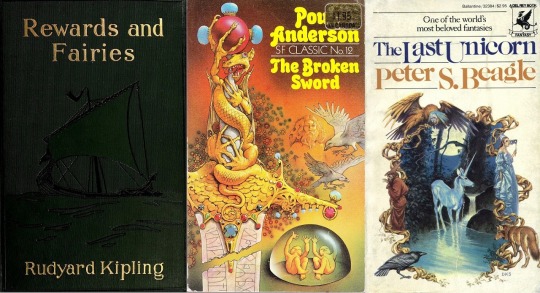
The old superstition kept coming up in fantasy fiction. In 1910 Rudyard Kipling wrote the very influential short story “Cold Iron” (in the collection Rewards and Fairies), where he explains invents the details of the fairies’ aversion to iron. They can’t bewitch a child wearing boots, because the boots have nails in the soles. They can’t pass under a doorway guarded by a horseshoe, but they can slip through the backdoor that people neglected to guard. Mortals live “on the near side of Cold Iron”, because there’s iron in every house, while fairies live “on the far side of Cold Iron”, and want nothing to do with it. And changelings brought up by fairies will go back to the world of mortals as soon they touch cold iron for the first time.
In Poul Anderson’s The Broken Sword (1954), we read:
“Let me tell you, boy, that you humans, weak and short-lived and unwitting, are nonetheless more strong than elves and trolls, aye, than giants and gods. And that you can touch cold iron is only one reason.”
In Peter S. Beagle’s The Last Unicorn (1968) the unicorn is imprisoned in an iron cage:
“She turned and turned in her prison, her body shrinking from the touch of the iron bars all around her. No creature of man’s night loves cold iron, and while the unicorn could endure its presence, the murderous smell of it seemed to turn her bones to sand and her blood to rain.”
Poul Anderson would come back to that idea in Operation Chaos (1971), where the worldbuilding’s premise is that magic and magical creatures have been reintroduced into the modern world, because a scientist “discovered he could degauss the effects of cold iron and release the goetic forces”. And that until then, they had been steadily declining, ever since the Iron Age came along.
There are a million examples, I’m just focusing on those that would have had a more direct influence on roleplaying games. However, I should note that all these say “cold iron” but mean “iron”. Yes, the fey call it cold, but they are a poetic bunch. You can’t expect Robin Goodfellow’s words to be pedestrian, now can you?
RPGs

And from there, fantasy roleplaying systems got the idea that Cold Iron is a special material that fey are vulnerable to. The term had been floating around since the early D&D days, but inconsistently, scattered in random sourcebooks, and not necessarily meaning anything else than iron. In 1st Edition’s Monster Manual (1977) it’s ghasts and quasits who are vulnerable to it, not any fey creature. Devils and/or fiends might dislike iron, powdered cold iron is a component in Magic Circle Against Evil, and “cold-wrought iron” makes a couple of appearances. For example, in AD&D it can strike Fool’s Gold and turn it back to its natural state, revealing the illusion.
Then Changeling: The Dreaming came along and made it a big deal, a fundamental rule, and an anathema to all fae:
Cold iron is the ultimate sign of Banality to changelings. ... Its presence makes changelings ill at ease, and cold iron weapons cause horrible, smoking wounds that rob changelings of Glamour and threaten their very existence.... The best way to think about cold iron is not as a thing, but as a process, a very low-tech process. It must be produced from iron ore over a charcoal fire. The resulting lump of black-gray material can then be forged (hammered) into useful shapes.
— Changeling: The Dreaming (2nd Edition, 1997)
So now that we know how iron works, does that description make sense? Well, if we assume that the iron ore is unceremoniously dumped on coals, it does not. You can’t smelt iron like that. If we assume that a bloomery is involved even though it’s not mentioned, then yes, this is broadly speaking how iron’s been made since the Iron Age, and until blast furnaces came into the picture. But the World of Darkness isn’t a pseudo-medieval setting, it’s modern urban fantasy. So the implication here is that “cold iron” is iron made the old way: you can’t buy it in the store, someone has to replicate ye olde process and do the whole thing by hand. Now, this is NOT how the term “cold iron” has been used in real life or fiction thus far, but hey, fantasy games are allowed to invent things.
Regardless, 3.5 borrowed the idea, and for the first time D&D made this a core rule. Now most fey creatures had damage reduction and took less damage from weapons and natural attacks, unless the weapon was made of Cold Iron:
“This iron, mined deep underground, known for its effectiveness against fey creatures, is forged at a lower temperature to preserve its delicate properties.”
— Player’s Handbook (3.5 Edition, 2003)
Pathfinder kept the rule, though 5e did not. And unlike Changeling, this definition left it somewhat ambiguous if we’re talking about a material with special composition (i.e. not iron) or made with a special process (i.e. iron but). The community was divided, threads were locked over this!
So until someone points me to new evidence, I’ll assume that the invention of cold iron as a special material, distinct from plain iron, should be attributed to TTRPGs.
#long post#cold iron#d&d#Changeling: The Dreaming#World of Darkness#Peter S. Beagle#The Last Unicorn#Rudyard Kipling#Poul Anderson#The Broken Sword#how to rogue#pathfinder#rogues in fiction#Operation Chaos#rogue superstitions#words of the trade#thieves' cant#ad&d#d&d history#1st edition#fey#3.5#fluff#trs
338 notes
·
View notes
Text
Okay gang, here's a silly little game. I've assembled six teams of blended Narnia and Tolkien/LotR characters. Here they are:
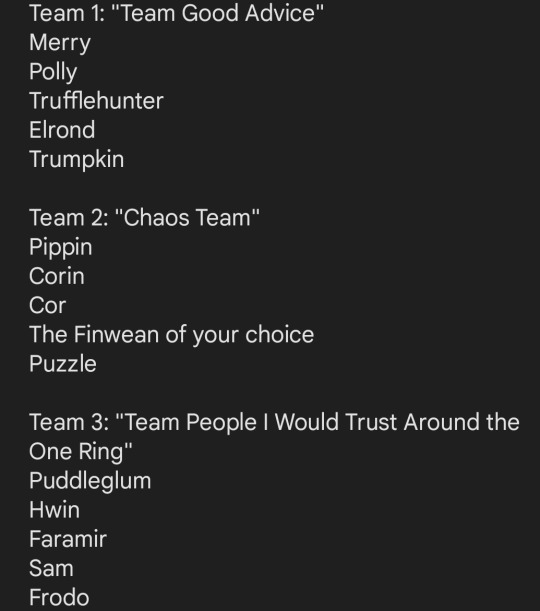
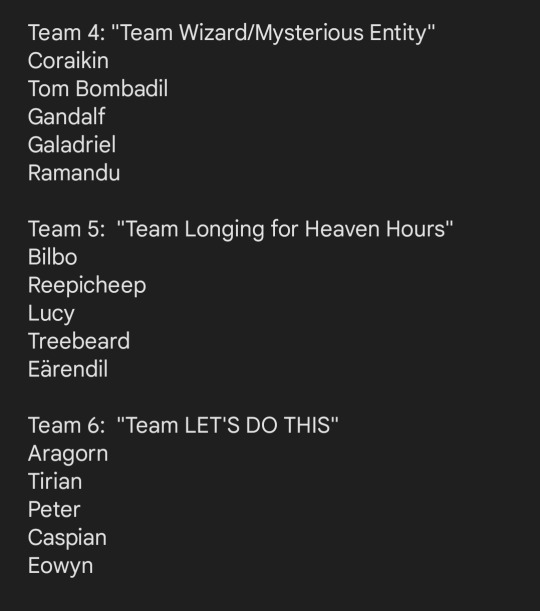
For bonus points, tell me in the tags where you're going on your road trip, who has what role (driving, snacks, aux) on the road, and what you'll stop off and see along the way
#this is shameless inspired by the lotr national parks poll#but the crossover potential is just too good#also for characters who wouldn't reasonably fit in said VW bus just handwave it#everyone basically fits okay?#narnia#pontifications and creations#ask me hard questions#tolkien legendarium#i myself am going with team 5 (to no one's shock)#we're gonna hit national parks across america#Bilbo and Treebeard can trade off as DJ#Eärendil gets to help drive and navigate#Lucy is in charge of snapping pics out the window#Reepicheep can lead us in some road trip games or something idk#i feel like this would be a really lovely group to just sit and stare at natural beauty in silence together#which is kinda my jam#occasionally pointing out something really especially lovely#would be fun#edit: as if I left put your fave character I'm sorry both these series have about a million so it was bound to happen#and for Narnia in particular I was trying to bias it towards Narnians rather than friends of narnia#also i was seriously tempted to do a 'team dragon' which would be all the tolkien dragons + eustace haha
296 notes
·
View notes
Text






i’m proud to be different. it’s the best thing about me.
KURT HUMMEL FROM GLEE (insp)
#glee#kurt hummel#my stuff#my edit#gleeedit#kehedit#kurthummeledit#klaine#100#episode: sectionals#song: and i am telling you i’m not going#episode: a very glee christmas#episode: wonderful#episode: old dog new tricks#episode: tested#song: love is a battlefield#episode: love love love#i hope yall like this!!! it took awhile so i hope it’s cute#trade baby queues for wide eyed browns
152 notes
·
View notes
Photo


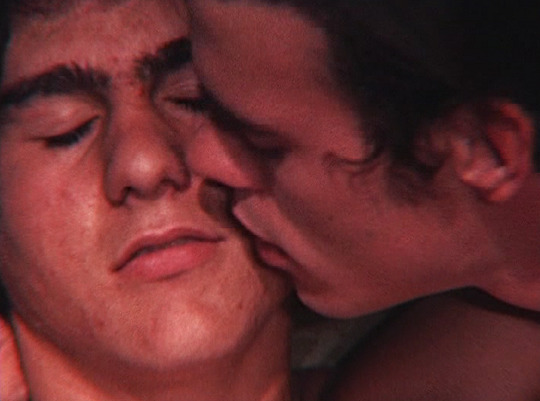
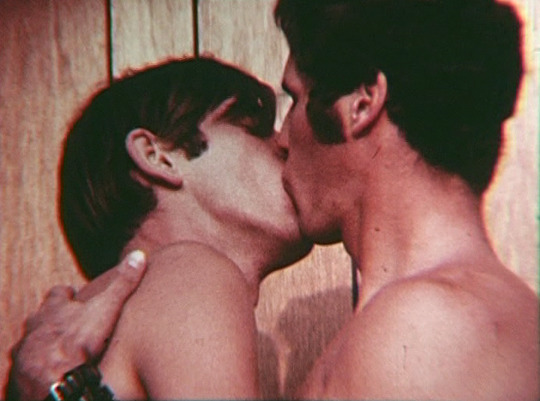

Jealous Cowboy (1970) // dir. Bob Mizer
Bike Shop Trade (1969) // dir. Bob Mizer
Vito and the Love Bandit (1971) // dir. Bob Mizer
Jonny’s Birthday Present (1970) // dir. Bob Mizer
Professor’s Sailor (1971) // dir. Bob Mizer
#Bob Mizer#Jealous Cowboy#Bike Shop Trade#Professor's Sailor#Jonny's Birthday Present#Vito and the Love Bandit#my caps#my edits#*bobmizer
1K notes
·
View notes
Text

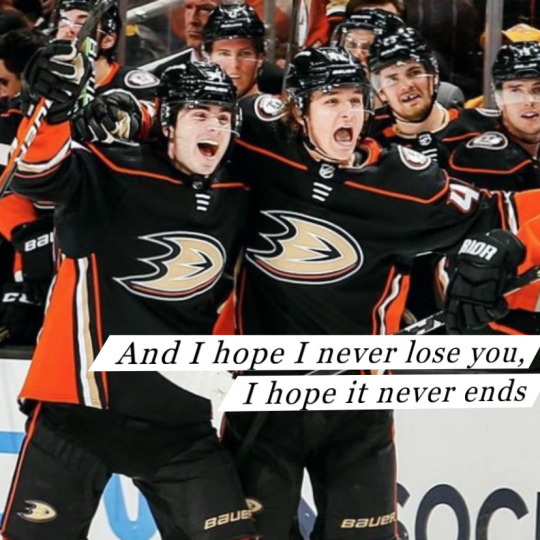


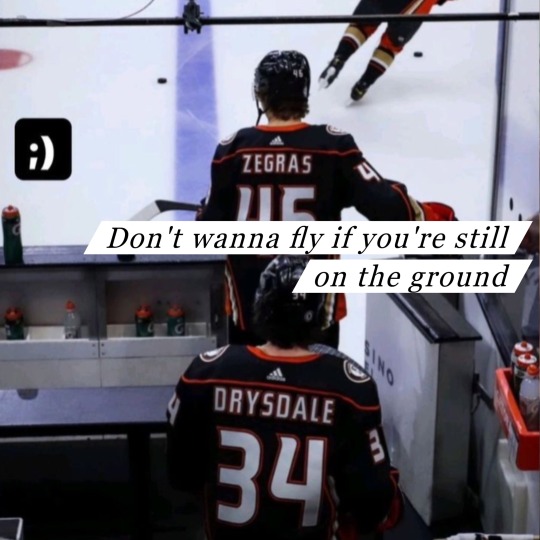

Jamie Drysdale, Philadelphia Flyer
(TrevorJamie x Taylor Swift)
#only felt fitting to get some Taylor swift quotes in here#Taylor swift lyrics#trevor zegras#jamie drysdale#trade#nhl#edits#annies edits#trevorjamie#611#116#3446#ducks#anaheim ducks#philadelphia flyers#ducklings#tz#jd#tzjd#Long live#new year’s day#i’m only me when i’m with you#you’re on your own kid#cornelia street#it’s nice to have a friend#drygras
148 notes
·
View notes
Text
cw: this got long sorry 😔 but creepy/perv bakugou, recording, film major bkg x art major reader, masturbation, coercion, dubcon before it just becomes con, voyeurism/exhibitionism
as an art major, you typically did some works for a few students on campus; for their plays, as background pieces while they danced, a cover for their released songs. it wasn’t out of the ordinary for people to ask you to create something for them, and you enjoyed it more often than not. but, you weren’t usually the art itself.
Bakugou is a friend’s friend that you’ve seen a few times, ran into at the library or at coffee shops. he’s a film major, and always looks so unhappy about the whole thing, as if he didn’t choose it himself. you joke to Mina that you think he’ll graduate and become one of those directors that hate everything and yell at the actors constantly and later on get sued for being a dickhead. you never say it to him though—you’ve never spoken more than a couple words to the man.
it’s why it shocks you when he approaches you one day. it’s after one of your painting classes, and he stands outside the door with a frown and his hands shoved in his pockets, his eyebrows scrunched as if pissed at the mere sight of you. he asks you, in that low and gruff tone of his, if you could star in his final project for the semester. says it’s supposed to be a film made with this criteria and that, but, you’ve kind of checked out on the conversation after the first sentence.
“You mean, you want me to create something and that be the star of your film?” you ask him, feeling so intimidated at his stature. he always seems to loom, his hair shadowing the lights above, creates a cast over a portion of his face, makes his eyes look…unsettling. like they’re looking straight through your flesh, can find the marrow in your bones. he scoffs like you’ve offended him, rolling his eyes into his skull, mouth pulled tight.
“No.” his voice is firm, gaze concentrated only on you, like the halls are empty and you’re the focus of his lens. “I want you to star in it.”
his words confuse you—you’ve never presented yourself as an actor before, never alluded to wanting to be in the spotlight if not for what you create with your hands. but he shuffles on his feet, looks desperate even. there’s some hemming and hawing for a minute or so—why not choose Mina?—she’s busy—why choose me?—‘cause you’d be perfect for my short film—what’s it about?—you’ll find out once you get the script.
and even after you hesitantly agree and get the script—you still don’t understand what you’re doing. why you’re here, why you’re the only person, why it has to be a solo film, why there’s damn near zero lines in the entirety of the have-to-be forty five minute film.
the scenes are all so long, and maybe it’s because movies aren’t your forte or chosen major, but you just don’t get it. one scene; you’re staring at yourself in the mirror while Bakugou holds a small, black camera over your shoulder. he’s eerily quiet behind you, whispers out a faint fuckin’ go when you have to wash your face in the sink, makes you do it over because your movements are too jerky and unnatural.
the rest of the scenes go that way; you doing regular at home activities, being put under a lens, quietly barked at to do this and move that way and fix your hair and remember to frown.
“Isn’t there another way to film this?” you ask him on the fifth day of shooting in his spacious loft. there’s a bubble bath scene coming up, one you dont understand the importance of, but Bakugou tells you it’s the most necessary part of the entire thing.
“No,” he grunts out, looking at you from under his lashes as he sits on the lid of the toilet. “But I’ll make it soapy, so the camera won’t see much.” the camera? much? you weren’t worried so much about what the camera captured as you were the man behind it. he looks at you with such intensity, you feel naked already despite the robe you wear that’s suspiciously already your size.
he leaves the bathroom when you sink in the hot water, returns before you can say it’s okay, hears the water splashing and thinks that’s good enough. he kneels on the floor beside you, camera pointed directly in your face, makes your chest hot and your skin feel prickly. the scene passes on regularly enough; you run the water over your arms, tilt your head back as you sigh, whisper the few lines scripted, lean back and close your eyes, sigh again. it’s almost relaxing, makes you forget about the friend of a friend recording you naked right now. almost.
“Touch yourself.” Bakugou suddenly demands, hushed and quiet behind the camera. your eyes immediately shoot open, looking to him in question, how he’s eerily still in his spot hovering over you.
“Huh?” you ask, unsure if you heard him correctly, looking around the rounded lens in your face, trying to ignore the red blinking light. but Bakugou only frowns.
“It’s a masturbation scene. Touch yourself.” he repeats, voice louder, more demanding this time. your stomach twists at the thought of doing something so intimate in front of him. he’s a handsome guy, for sure, even made you consider asking him out after this, figured he was just serious about his work and awkward about certain things. but…something had been off about this entire thing since the start.
“But—but I don’t, I’m not,” you stutter, sitting up a little, the bubbles covering your chest starting to disperse with your movements. but Bakugou only sits a little higher on his knees, finally pulling the camera away from his face for the first time since he’s asked you to do this for him.
“You want me to fail?” he asks, booming voice eerily quiet in the silent bathroom, carmine eyes dull, shaded over with something terrible. “Then do it.” he tells you when you shake your head quickly.
you stare at him until he gets back into position again, camera back pointed at you. when he doesn’t say anything else, you swallow thickly, wondering if the art that will come out of this will be worth it. so you listen, sneak a hand under the water, start touching yourself in a way you never have in front of anyone.
is it bad to say that it’s exhilarating? being watched and recorded by someone who breathes so heavily every time your voice hiccups? being directed to touch your chest next when the suds start to disappear and your nipples start to peek through? is it bad that you want him to send you this portion of his film, only, just so you can watch yourself again and again? make a portrait of yourself with your fingers on your nipples and your knees raising from the water and your head thrown back from the intensity in oil pastels?
“That’s a wrap.” Bakugou announces when you finish, head spinning and still panting. you look over to him, how he closes the camera, the obvious bulge in his pants. “I’ll get you a towel.”
you wonder when’s the next time he’ll need you. or better yet—maybe he could be the star in your final drawing project? you had finished it already but, what was the harm in starting over with him as your muse? as naked as you are? camera not blocking his face so you can paint the similarities of his blushing cheeks and eyes when you direct him to look at you? to touch his chest? to play with himself just like that?
#this got. so long. sowwy#but I thought about this ummmm Sunday night#but I was DRAINED from writing 7k words of scorned past midnight and then having to edit it skdjfkf#so I was like. okay. put this idea in the drafts. NOW ms dory memory#anddddd I love this so very much#would’ve loved to turn this into a full fic#but it’s so exhausting trying to write long fics recently bc of this multichap#I’m just not used to it and I can’t do two things at the same time#and I already have like 9 fics on my list to write!!!! lol#but there is something so alluring about film major bkg 2 me#I think hes awkward and comes off as mean but he really is just that serious about his work#but he’s#also a creep for you LOL#definitely think he agrees to become ur muse for art as like a trade off#and you get that boy into SO many humiliating positions 😵💫#I need. to lie down. anyway.#I wrote this at 1am and was scared to post it then cause I didn’t think anyone would see it#so here it is in the morning :)#bakugou treats! 🍬#—new treat in the streets! 🍫
167 notes
·
View notes
Text

yayaya art trade with @nightmaretherabbit!!! i drew his vanessa design and they drew mine :3333
#my art#vanessa fnaf#fnaf vanessa#vanessa sb#security breach#fnaf security breach#fnaf sb#fnaf#fnaf fanart#art trade#mutuals#QUICK EDIT BECAUSE I FORGOT HER FRECKLES HBHBHBH SORRY...
109 notes
·
View notes
Text

drew my shield team :)
#pokemon#gyarados#whimsicott#cinderace#mudsdale#noivern#galvantula#doods#i ran into a shiny so early i was just like BRO? im not used to new gens shiny rates 😭#candyfloss is an npc trade i just call her candy for short lol#EDIT: I FORGOT THE GYARADOS WHISKERS NOO 😭😭
156 notes
·
View notes
Photo

💙 𝐹𝓇𝒾𝑒𝓃𝒹𝓈 𝒾𝓃 𝐻𝒾𝓈𝓊𝒾 🧡
#pokemon legends arceus#pla#pokemon#adaman#irida#akari#rei#adaman pokemon#irida pokemon#akari pokemon#rei pokemon#pokemon tcg#pokemon trading card game#miette's edits
910 notes
·
View notes
Text

Dads
#i love love#zukka#may or may not have to do with a tweet i tweeted#i miss themmmmmmmm#edit i forgot to mention the beads. how could i. it could be seen as anything but i have been emotional about se asian history so#ok prehistoric time. se asian traded w india and india has these orange beads#they are just. so pretty. I just have to include them#THERE WERE ALSO TINY TIGERS. more likely to come from china though#i love. human history. so much
2K notes
·
View notes
Text
sometimes, only sometimes, i think back to the moment when scanlan came back to vox machina — and they had their first night in the scanlan's magnificent mansion after a long while — and scanlan played cards with vax while catching up on things that happened during the year they've been apart — and vax said i am happy and it took scanlan by such surprise he asked again as if he wasn't sure he had heard him right.
the last thing he remembered of vax was him on a really low point, mirrored by his own, filled with pain, guilt, fear and a myriad of unknown troubles atop of that. and then he left to fix himself, find his own, and vax had a moment to do this too, it seems, and scanlan was so happy for him. so happy and so sad he wasn't there to witness it. yet, still happy.
and to think, as i do sometimes, that scanlan wanted vax — now healed, happy vax — to live, to have more time and yet, was forced to choose in a matter of moments between the whole world and a little percent chance of saving his friend. it's so cruel that it happened to be him to make that decision.
it's so cruel that it's sam who had to give up a ninth level spell to stop the mad god and not to save liam's character.
sometimes i just think and sometimes i think i shouldn't...
#tiktok edits keep hurtin me with edits of this particular moments#and i legitimately keep crying#it's just so#hard not to#i miss vax so much#and i am so heartbroken by what kind of life he didn't have#and yet it was a beautiful ending to an impactfull story#and i wouldn't trade this heartbreak for the world#it keep me living#the way it seems sa's c2 character tries to keep liam's c2 character alive#these two#fucking hell these two#vax'ildan#scanlan shorthalt#liam o'brien#sam riegel#vox machina#critical role
79 notes
·
View notes
Text


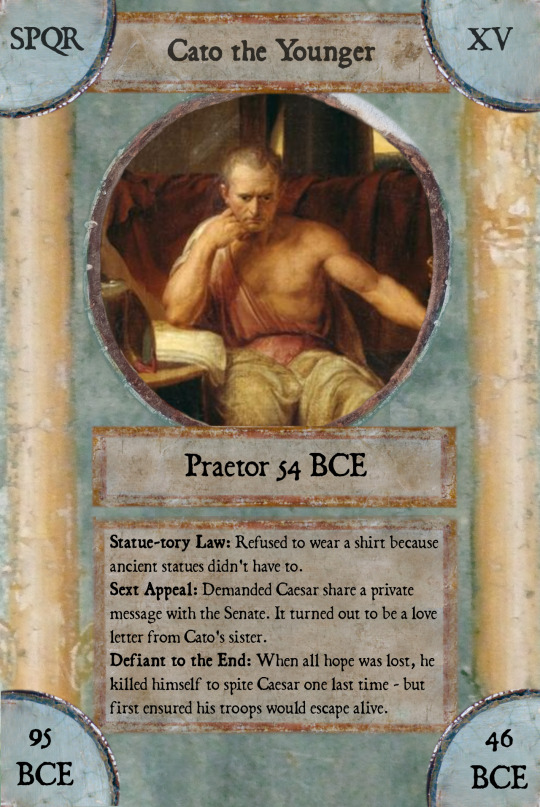

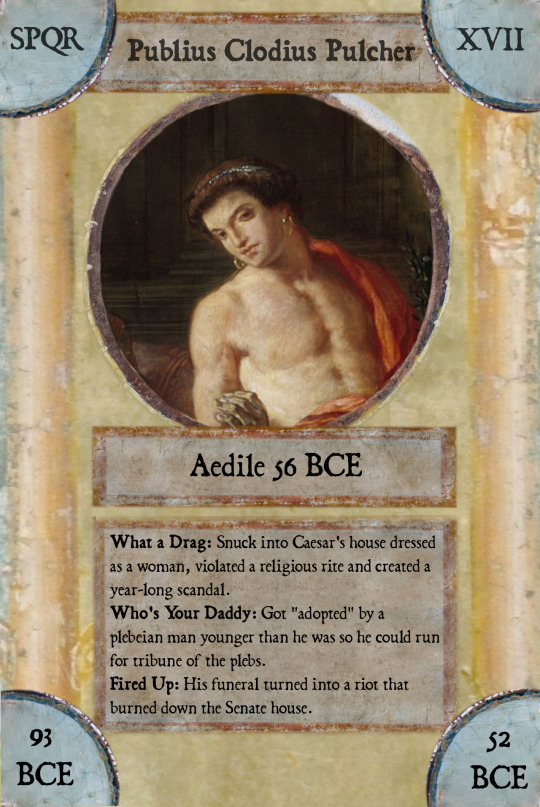
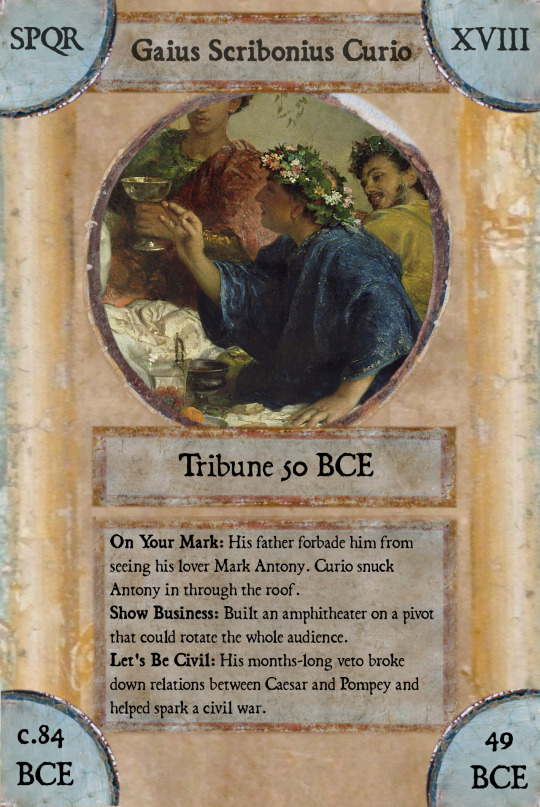
Ancient Roman trading cards: Tribune Trouble!
Historical notes and artist attributions under the cut. For more silly trading cards, check out the Julio-Claudians.
Many famous Romans were tribunes of the plebs at some point, but I'm only featuring those who pushed that office to its limit, usually by causing trouble.
My aim here is to capture some of their personality while making history fun and silly. So, some of these facts come from ancient sources that might be biased or wrong, but I have tried to keep it plausible. Some of the art has been adapted from paintings of other Romans because it felt fitting for these guys. If you want to learn more about them, check out my favorite Roman history books!
Background color = highest office achieved. Orange for quaestors and tribunes, yellow for aediles, green for praetors, blue for consuls, purple for emperors and red for dictators. Everybody else gets gray.
Paintings featured:
Cornelia, mother of the Gracchi by Joseph-Benoit Suvée
Farewell of Gaius Gracchus to his family by Dióscoro Puebla
Cato Uticensis by Josef Abel
Lictors bringing Brutus the bodies of his sons by Jacques-Louis David
Marcus Aurelius by Eugene Delacroix
A Roman Feast by Roberto Bompiani
Other art textures come from the frescoes of Pompeii.
#jlrrt speaks#ancient roman trading cards#suicide mention#gaius gracchus#tiberius gracchus#cato the younger#titus annius milo#publius clodius pulcher#gaius scribonius curio#just roman memes#my edits
131 notes
·
View notes
Text





the original glee club members and their instagrams
template can be found here
#my stuff#my edit#glee#gleesource#gleeedit#kehedit#glee insta series#rachel berry#kurt hummel#tina cohen chang#mercedes jones#artie abrams#100#i put SO much time and effort into this#eventually i may make ones for more characters#trade baby queues for wide eyed browns
145 notes
·
View notes
Photo

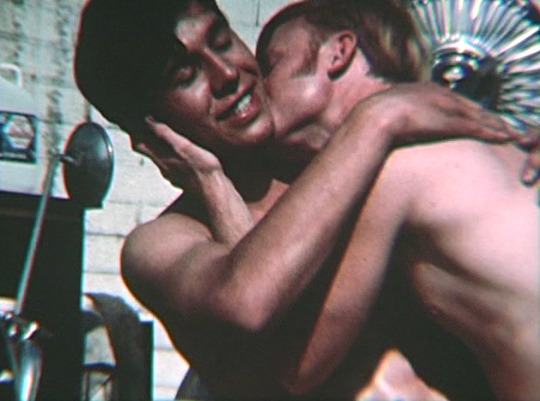
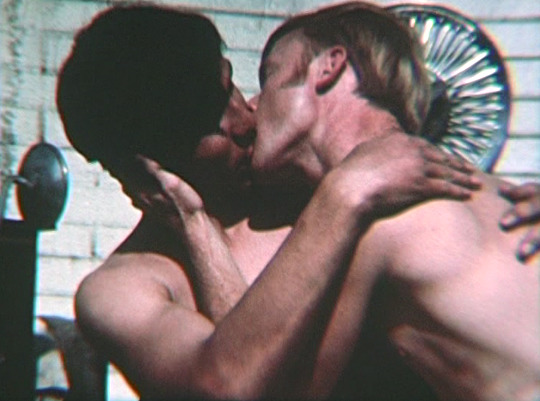
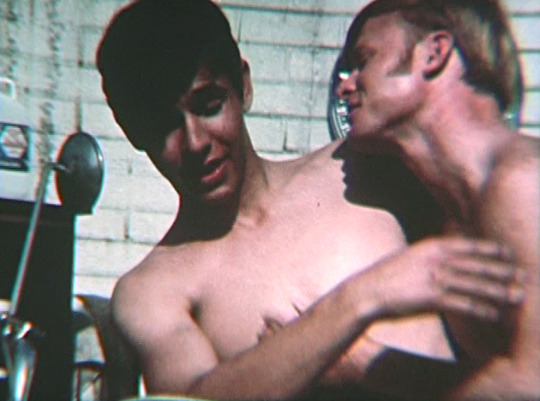
Bike Shop Trade (1969) // dir. Bob Mizer
1K notes
·
View notes
Text

Luxaeterna, a participant in the first true battle of the war between the Rainwings and Icewings, the Battle of Stolen Light. Her venom-fangs were torn out by an Icewing poacher, and after surviving and avoiding capture, replaced them with harder gemstone teeth. She’s well known for the number of Icewing skulls she’s impaled throughout the war. She is Boomslang and Quetzal’s great aunt. Postwar, she has been reunited with her living grandnephew and accompanies him for scale retrieval in the Ice and Sky Kingdoms.
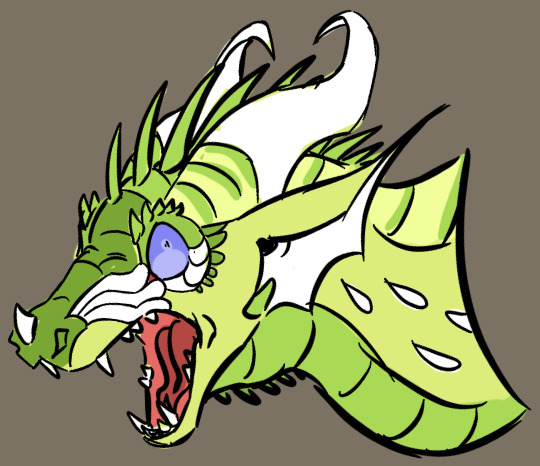
Quetzal in his last moments before being murdered by an Icewing poacher. He had sold Boomslang’s egg to the Icewings in the hopes of gaining immunity from the scale trade- but he learned far too late that a bargain can’t be kept with someone who wants to wear your skin.
#wof#wings of fire#oc#my art#luxaeterna#quetzal#scale retrieval is going to the kingdoms participating in the rainscale trade and-#confiscating anything made from rainwings to be brought home for identification#this also includes live farm prisoners/poaching victims#the identification is helped by the scientific community within the rainforest’s nightwing village#but (as you can probably imagine) its a deeply stressful process for everyone who’s missing someone.#the hope that you’ll have a venom match with anyone who’s been returned alive#and the dread of the possibilty that your reunion will be with an objected your loved one was turned into.#i cant wait to talk abt the nightwings here btw bc they have some shit going on here.#(rainforest village is very clearly against the rainscale trade but the peninsula kingdom participated in poaching)#edit wow i was nearly asleep typing those tags uh.#*objected is meant to be object#beneath her talons
45 notes
·
View notes